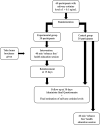Effect of educational intervention in reducing exposure to second hand tobacco smoke among 12-year-old children as determined by their salivary cotinine levels and knowledge, attitude and behavior - a randomized controlled trial
- PMID: 37842016
- PMCID: PMC10569313
- DOI: 10.3389/froh.2023.1277307
Effect of educational intervention in reducing exposure to second hand tobacco smoke among 12-year-old children as determined by their salivary cotinine levels and knowledge, attitude and behavior - a randomized controlled trial
Abstract
Background: Tobacco use is one of the most important public health concerns, with approximately 8.7 million tobacco-related deaths each year, primarily in low- and middle-income countries. Even more concerning is the fact that 1.3 million of these deaths are seen in nonsmokers, including babies and children. This study was performed to determine whether a school-based "tobacco-free" educational intervention program among 12-year-old children would be effective in reducing their exposure to second-hand tobacco smoke (SHS) by improving their knowledge, attitude and behavior post intervention and estimating salivary cotinine levels as markers of SHS exposure.
Materials and method: A randomized controlled trial was performed by a cluster random sampling technique, with 30 participants each in the experimental and control arms. A knowledge, attitude, avoidance behavior and self-efficacy of avoidance questionnaire was administered, followed by estimation of salivary cotinine levels. The experimental arm received the "tobacco-free" intervention, which comprised a 40-min health education session, with the first follow-up at 15 days and the second at 30 days after the intervention. After the intervention, the questionnaire was readministered, followed by re-estimation of salivary cotinine levels.
Results: One month after the intervention, the number of participants who had a smoker who lived with them and the number of people who smoked inside the house were reduced in the experimental group compared to the control group. In the knowledge domain and the attitude domain, 80% and 60% of the items showed a statistically significant improvement in the experimental group compared to the control group. In the avoidance behavior domain and the Self-Efficacy of Avoidance Domain, all the items showed improvement in the experimental group compared to the control group. When the mean salivary cotinine levels were compared pre- and postintervention, it was found that although the mean postintervention salivary cotinine levels increased in both the experimental and control groups, the increase was less in the experimental group than in the control group.
Conclusion: The present study has been shown to be effective in improving the knowledge, attitude and avoidance behavior of adolescents toward exposure to secondhand smoke.
Keywords: adolescent; cotinine; environmental exposure; health education; randomized controlled trial; saliva; second-hand smoke; tobacco.
© 2023 Rao, Rungta, M, Unnikrishnan, Shenoy, Rao and Shetty.
Conflict of interest statement
The authors declare that the research was conducted in the absence of any commercial or financial relationships that could be construed as a potential conflict of interest.
Similar articles
-
Effectiveness of a School-Based 'Tobacco Free' Intervention on Adolescents' Knowledge and Exposure to Second Hand Tobacco Smoke - A Multiphase Study.Asian Pac J Cancer Prev. 2019 Dec 1;20(12):3533-3537. doi: 10.31557/APJCP.2019.20.12.3533. Asian Pac J Cancer Prev. 2019. PMID: 31870091 Free PMC article. Review.
-
Exposure to Second Hand Tobacco Smoke among 12 year old Adolescents in Mangalore, Karnataka - A Descriptive Study.Asian Pac J Cancer Prev. 2021 Mar 1;22(3):827-835. doi: 10.31557/APJCP.2021.22.3.827. Asian Pac J Cancer Prev. 2021. PMID: 33773547 Free PMC article.
-
Third-hand exposure at homes: Assessment using salivary cotinine.Environ Res. 2021 May;196:110393. doi: 10.1016/j.envres.2020.110393. Epub 2020 Oct 28. Environ Res. 2021. PMID: 33129855
-
Children Learning About Secondhand Smoke (CLASS II): A Pilot Cluster Randomized Controlled Trial.Nicotine Tob Res. 2019 Apr 17;21(5):670-677. doi: 10.1093/ntr/nty090. Nicotine Tob Res. 2019. PMID: 29771390 Free PMC article. Clinical Trial.
-
Serum cotinine cut-points for secondhand smoke exposure assessment in children under 5 years: A systemic review.PLoS One. 2022 May 5;17(5):e0267319. doi: 10.1371/journal.pone.0267319. eCollection 2022. PLoS One. 2022. PMID: 35511766 Free PMC article.
Cited by
-
The Effect of Health Belief Model-Based Creative Drama Education on Health Locus of Control and Smoking Perception in Adolescents: A Randomized Controlled Trial.Public Health Nurs. 2025 May-Jun;42(3):1343-1353. doi: 10.1111/phn.13550. Epub 2025 Mar 6. Public Health Nurs. 2025. PMID: 40047297 Free PMC article. Clinical Trial.
References
-
- World Health Organization. WHO report on the global tobacco epidemic, 2023: protect people from tobacco smoke. World Health Organization. (2023). ISBN 978-92-4-007716-4 (electronic version) Available at https://apps.who.int/iris/handle/10665/372043 (Accessed on 16 July 2023).
-
- Global Youth Tobacco survey (GYTS) Factsheet India. (2019). Ministry of Health and Family Welfare, Government of India. Available at: https://ntcp.mohfw.gov.in/assets/document/National_Fact_Sheet_of_fourth_... (Accessed on 12 Sep 2023).
LinkOut - more resources
Full Text Sources


